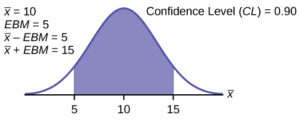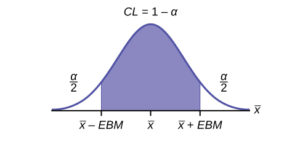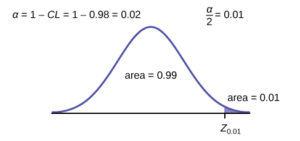Confidence Intervals
28 Single Population Mean using the Normal Distribution
A confidence interval for a population mean with a known standard deviation is based on the fact that the sample means follow an approximately normal distribution. Suppose that our sample has a mean of $\bar x = 10$and we have constructed the 90% confidence interval (5, 15) where E = 5.
Calculating the Confidence Interval
To construct a confidence interval for a single unknown population mean μ, where the population standard deviation is known, we need $\bar x$ as an estimate for μ and we need the margin of error. Here, the margin of error ( E ) is called the error bound for a population mean (abbreviated E ). The sample mean $\bar x$ is the point estimate of the unknown population mean μ.
The confidence interval estimate will have the form:
(point estimate – error bound, point estimate + error bound) or, in symbols, $\left(\bar x-E, \bar x + E \right)$
The margin of error ( E ) depends on the confidence level (abbreviated CL). The confidence level is often considered the probability that the calculated confidence interval estimate will contain the true population parameter. However, it is more accurate to state that the confidence level is the percent of confidence intervals that contain the true population parameter when repeated samples are taken. Most often, it is the choice of the person constructing the confidence interval to choose a confidence level of 90% or higher because that person wants to be reasonably certain of his or her conclusions.
There is another probability called alpha (α). α is related to the confidence level, CL. α is the probability that the interval does not contain the unknown population parameter.
Mathematically, α + CL = 1.
Example 7.1
- Suppose we have collected data from a sample. We know the sample mean but we do not know the mean for the entire population.
- The sample mean is seven, and the error bound for the mean is 2.5.
$\bar x = 7$ and $E = 2.5$
The confidence interval is (7 – 2.5, 7 + 2.5), and calculating the values gives (4.5, 9.5).
If the confidence level (CL) is 95%, then we say that, “We estimate with 95% confidence that the true value of the population mean is between 4.5 and 9.5.”
Try It 7.1
Suppose we have data from a sample. The sample mean is 15, and the error bound for the mean is 3.2.
What is the confidence interval estimate for the population mean?
A confidence interval for a population mean with a known standard deviation is based on the fact that the sample means follow an approximately normal distribution. Suppose that our sample has a mean of
$\bar x = 10$, and we have constructed the 90% confidence interval (5, 15) where E = 5.
To get a 90% confidence interval, we must include the central 90% of the probability of the normal distribution. If we include the central 90%, we leave out a total of α = 10% in both tails, or 5% in each tail, of the normal distribution.

To capture the central 90%, we must go out 1.645 “standard deviations” on either side of the calculated sample mean. The value 1.645 is the z-score from a standard normal probability distribution that puts an area of 0.90 in the center, an area of 0.05 in the far left tail, and an area of 0.05 in the far right tail.
It is important that the “standard deviation” used must be appropriate for the parameter we are estimating, so in this section we need to use the standard deviation that applies to sample means, which is $\frac{\sigma}{\sqrt{n}}$. The fraction $\frac{\sigma}{\sqrt{n}}$ is commonly called the “standard error of the mean” in order to distinguish clearly the standard deviation for a mean from the population standard deviation σ.
- $\bar X$ is normally distributed, that is, $\bar X \sim N \left(\mu_X, \frac{\sigma}{\sqrt{n}}\right)$
- When the population standard deviation σ is known, we use a normal distribution to calculate the error bound.
Calculating the Confidence Interval
To construct a confidence interval estimate for an unknown population mean, we need data from a random sample. The steps to construct and interpret the confidence interval are:
- Calculate the sample mean $\bar x$ from the sample data. Remember, in this section we already know the population standard deviation σ.
- Find the z-score that corresponds to the confidence level.
- Calculate the error bound E .
- Construct the confidence interval.
- Write a sentence that interprets the estimate in the context of the situation in the problem. (Explain what the confidence interval means, in the words of the problem.)
We will first examine each step in more detail, and then illustrate the process with some examples.
Finding the z-score for the Stated Confidence Level
When we know the population standard deviation σ, we use a standard normal distribution to calculate the error bound E and construct the confidence interval. We need to find the value of z that puts an area equal to the confidence level (in decimal form) in the middle of the standard normal distribution Z ~ N(0, 1).
The confidence level, CL, is the area in the middle of the standard normal distribution. CL = 1 – α, so α is the area that is split equally between the two tails. Each of the tails contains an area equal to $\alpha/2$
The z-score that has an area to the right of $\alpha/2$ is denoted by $z_{\alpha/2}$.
For example, when CL = 0.95, α = 0.05 and $\alpha/2 = 0.025$; we write $z_{\alpha/2} = z_{0.025}$.
The area to the right of z0.025 is 0.025 and the area to the left of z0.025 is 1 – 0.025 = 0.975.
$z_{\alpha/2} = z_{0.025} = 1.96$, using a spreadsheet, calculator or a standard normal probability table.
Calculating the Margin of Error ( E )
The Margin of Error formula for an unknown population mean μ when the population standard deviation σ is known is
- $E = z_{\alpha/2} \cdot \frac{\sigma}{\sqrt{n}}$
Constructing the Confidence Interval
- The confidence interval estimate has the format $(\bar x – E, \bar x +E)$.
The graph gives a picture of the entire situation.
$CL + \frac{\alpha}{2}+ \frac{\alpha}{2}= CL +\alpha = 1$

Writing the Interpretation
The interpretation should clearly state the confidence level (CL), explain what population parameter is being estimated (here, a population mean), and state the confidence interval (both endpoints). “We estimate with ___% confidence that the true population mean (include the context of the problem) is between ___ and ___ (include appropriate units).”
Example 7.2
Suppose scores on exams in statistics are normally distributed with an unknown population mean and a population standard deviation of three points. A random sample of 36 scores is taken and gives a sample mean (sample mean score) of 68. Find a confidence interval estimate for the population mean exam score (the mean score on all exams).
Find a 90% confidence interval for the true (population) mean of statistics exam scores.
Try It 7.2
Suppose average pizza delivery times are normally distributed with an unknown population mean and a population standard deviation of six minutes. A random sample of 28 pizza delivery restaurants is taken and has a sample mean delivery time of 36 minutes.
Find a 90% confidence interval estimate for the population mean delivery time.
Example 7.3
The Specific Absorption Rate (SAR) for a cell phone measures the amount of radio frequency (RF) energy absorbed by the user’s body when using the handset. Every cell phone emits RF energy. Different phone models have different SAR measures. To receive certification from the Federal Communications Commission (FCC) for sale in the United States, the SAR level for a cell phone must be no more than 1.6 watts per kilogram. Table 7.1 below shows the highest SAR level for a random selection of cell phone models as measured by the FCC.
| Phone Model | SAR | Phone Model | SAR | Phone Model | SAR |
|---|---|---|---|---|---|
| Apple iPhone 4S | 1.11 | LG Ally | 1.36 | Pantech Laser | 0.74 |
| BlackBerry Pearl 8120 | 1.48 | LG AX275 | 1.34 | Samsung Character | 0.5 |
| BlackBerry Tour 9630 | 1.43 | LG Cosmos | 1.18 | Samsung Epic 4G Touch | 0.4 |
| Cricket TXTM8 | 1.3 | LG CU515 | 1.3 | Samsung M240 | 0.867 |
| HP/Palm Centro | 1.09 | LG Trax CU575 | 1.26 | Samsung Messager III SCH-R750 | 0.68 |
| HTC One V | 0.455 | Motorola Q9h | 1.29 | Samsung Nexus S | 0.51 |
| HTC Touch Pro 2 | 1.41 | Motorola Razr2 V8 | 0.36 | Samsung SGH-A227 | 1.13 |
| Huawei M835 Ideos | 0.82 | Motorola Razr2 V9 | 0.52 | SGH-a107 GoPhone | 0.3 |
| Kyocera DuraPlus | 0.78 | Motorola V195s | 1.6 | Sony W350a | 1.48 |
| Kyocera K127 Marbl | 1.25 | Nokia 1680 | 1.39 | T-Mobile Concord | 1.38 |
Find a 98% confidence interval for the true (population) mean of the Specific Absorption Rates (SARs) for cell phones. Assume that the population standard deviation is σ = 0.337.
Try It 7.3
Table 7.2 below shows a different random sampling of 20 cell phone models. Use this data to calculate a 93% confidence interval for the true mean SAR for cell phones certified for use in the United States. As previously, assume that the population standard deviation is σ = 0.337.
| Phone Model | SAR | Phone Model | SAR |
|---|---|---|---|
| Blackberry Pearl 8120 | 1.48 | Nokia E71x | 1.53 |
| HTC Evo Design 4G | 0.8 | Nokia N75 | 0.68 |
| HTC Freestyle | 1.15 | Nokia N79 | 1.4 |
| LG Ally | 1.36 | Sagem Puma | 1.24 |
| LG Fathom | 0.77 | Samsung Fascinate | 0.57 |
| LG Optimus Vu | 0.462 | Samsung Infuse 4G | 0.2 |
| Motorola Cliq XT | 1.36 | Samsung Nexus S | 0.51 |
| Motorola Droid Pro | 1.39 | Samsung Replenish | 0.3 |
| Motorola Droid Razr M | 1.3 | Sony W518a Walkman | 0.73 |
| Nokia 7705 Twist | 0.7 | ZTE C79 | 0.869 |
Notice the difference in the confidence intervals calculated in Example 7.3 and the following Try It exercise. These intervals are different for several reasons: they were calculated from different samples, the samples were different sizes, and the intervals were calculated for different levels of confidence. Even though the intervals are different, they do not yield conflicting information. The effects of these kinds of changes are the subject of the next section in this chapter.
Changing the Confidence Level or Sample Size
Example 7.4
Suppose we change the original problem in Example 7.2 by using a 95% confidence level. Find a 95% confidence interval for the true (population) mean statistics exam score.
Try It 7.4
Refer back to the pizza-delivery Try It exercise. The population standard deviation is six minutes and the sample mean deliver time is 36 minutes. Use a sample size of 20. Find a 95% confidence interval estimate for the true mean pizza delivery time.
Example 7.5
Suppose we change the original problem in Example 7.2 to see what happens to the error bound if the sample size is changed.
Leave everything the same except the sample size. Use the original 90% confidence level. What happens to the error bound and the confidence interval if we increase the sample size and use n = 100 instead of n = 36? What happens if we decrease the sample size to n = 25 instead of n = 36?
- $\bar x = 68$
- $E = z_{\alpha/2}\cdot \frac{\sigma}{\sqrt{n}}$
- σ = 3; The confidence level is 90% (CL=0.90);
$z_{\alpha/2}=z_{0.05}=1.645$
- Increasing the sample size causes the error bound to decrease, making the confidence interval narrower.
- Decreasing the sample size causes the error bound to increase, making the confidence interval wider.
Try It 7.5
Refer back to the pizza-delivery Try It exercise. The mean delivery time is 36 minutes and the population standard deviation is six minutes. Assume the sample size is changed to 50 restaurants with the same sample mean. Find a 90% confidence interval estimate for the population mean delivery time.
Working Backwards to Find the Error Bound or Sample Mean
When we calculate a confidence interval, we find the sample mean, calculate the error bound, and use them to calculate the confidence interval. However, sometimes when we read statistical studies, the study may state the confidence interval only. If we know the confidence interval, we can work backwards to find both the error bound and the sample mean.
- From the upper value for the interval, subtract the sample mean,
- OR, from the upper value for the interval, subtract the lower value. Then divide the difference by two.
- Subtract the error bound from the upper value of the confidence interval,
- OR, average the upper and lower endpoints of the confidence interval.
Notice that there are two methods to perform each calculation. You can choose the method that is easier to use with the information you know.
Example 7.6
Suppose we know that a confidence interval is (67.18, 68.82) and we want to find the error bound. We may know that the sample mean is 68, or perhaps our source only gave the confidence interval and did not tell us the value of the sample mean.
- If we know that the sample mean is 68: E = 68.82 – 68 = 0.82.
- If we don’t know the sample mean: $E=\frac{68.82-67.18}{2} = 0.82$
- If we know the error bound: $\bar x = 68.82-0.82=68$
- If we don’t know the error bound: $\bar x = \frac{67.18+68.82}{2}=68$
Try It 7.6
Suppose we know that a confidence interval is (42.12, 47.88). Find the error bound and the sample mean.
Calculating the Sample Size n
If researchers desire a specific margin of error, then they can use the error bound formula to calculate the required sample size.
The error bound formula for a population mean when the population standard deviation is known is
$E = z_{\alpha/2}\cdot \frac{\sigma}{\sqrt{n}}$.
The formula for sample size is $\frac{z^2 \sigma^2}{E^2}$ found by solving the error bound formula for n.
In this formula, z is $z_{\alpha/2}$, corresponding to the desired confidence level. A researcher planning a study who wants a specified confidence level and error bound can use this formula to calculate the size of the sample needed for the study.
Example 7.7
The population standard deviation for the age of Sierra College students is 15 years. If we want to be 95% confident that the sample mean age is within two years of the true population mean age of Sierra College students, how many randomly selected Sierra College students must be surveyed?
- From the problem, we know that σ = 15 and E = 2.
- z = z0.025 = 1.96, because the confidence level is 95%.
- $n = \frac{z^2 \sigma^2}{E^2} = \frac{(1.96)^2 (15)^2}{2^2}=216.09$ using the sample size equation.
- Use n = 217: Always round the answer UP to the next higher integer to ensure that the sample size is large enough.
Therefore, 217 Sierra College students should be surveyed in order to be 95% confident that we are within two years of the true population mean age of Sierra College students.


